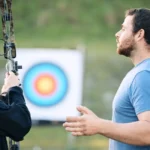There is no doubt that starting an archery journey can be an exhilarating experience. Still, at the same time, it can be filled with questions and uncertainties, particularly when choosing the best equipment for your needs. One of the most frequently asked questions among budding archers is whether or not a designed to be operated left hand vs right hand bow .The importance of this distinction cannot be overstated because it profoundly affects the level of comfort, accuracy, and overall performance in archery.
We dive into the intricacies of the left hand compound bow in this comprehensive guide and provide the information you need to decide which bow suits your needs. We also explain how you can determine which bow is oriented correctly.
Understanding Bow Orientation: Left Hand vs Right Hand Bow
Left handed compound bows differ from right-handed compound bows primarily in their design, with left handed compound bows being designed to accommodate the dominant eye of the archer as opposed to the dominant hand. This is one of the most essential concepts in archery since precision relies on sight substantially more than it does on hand dominance.
Those archers with a dominant left eye will find a left handed compound bow more suitable for their shooting style. In this scenario, you would hold the bow with your right hand and draw the string with your left hand while holding the bow. You may also prefer a right-handed compound bow if your dominant eye is on the right side of your head. In this case, have the bow with your most substantial hand while drawing with your right hand.
Alternatively, if your dominant hand and dominant eye do not align (cross-dominance), you may choose a bow based on your dominant eye to maximize precision and comfort.
Deciphering the Hand Orientation of a Compound Bow
When determining whether a compound bow is crafted for left hand vs right hand bow users, it is necessary to inspect various components of the bow, as every element plays a crucial role in determining its overall function and alignment. This article explores the key features that determine which direction your compound bow should be pointed.
Sight placement
There is no doubt that the sight placement is a clear indicator of the bow’s design. There is a common misconception that if a bow is right-handed, the sight will be mounted on the opposite side, allowing the right-handed bow hunter to aim accurately with his dominant eye. In contrast, a bow made to accommodate left-eye dominance will feature the sight on the opposite side from one made for right-eye dominance. It is important to note that sights are crucial to precise shooting, so their position in determining how a bow is oriented is vital.
The riser’s position
As well as the riser, other components need to be considered. This part provides a place for you to mount other elements, such as rests and sights that are mounted to the rest, along with housing the grip and shelf for the arrow. A bow’s handiness will be determined by how the riser is positioned. In the case of a left handed compound bow, the riser is set to the left so that it can be easily reached by left-eye dominant archers, making it more accessible and functional. For right-handed bows, the riser will be located on the right side of the bow, in the same way as for left hand compound bows.
Analyzing the Arrow Rest and Curve
It is also imperative to note that the arrow rest is another defining feature that ensures the arrow remains steady during the shot and is not in contact with the bow. The performance and accuracy of the system could be affected as a consequence. There are several reasons why the curvature and placement of the arrow rest can help determine the orientation of the bow: if the rest curves towards the right and is positioned to the left, it is more likely that the bow is right-handed, and vice versa for left handed compound bow.
Positioning of stabilizers
There are many reasons why stabilizers play such an essential role in the archery world. They enhance the bow’s inertia, reduce vibration, and help keep the archer stable during a shot. In addition to the position of stabilizers, it is also possible to use the position of stabilizers to figure out an object’s orientation. Generally, with left handed compound bow, stabilizers are placed on the right side, while right-handed bows are placed on the left side.
Frequently Asked Questions (FAQs).
Q: How do I determine my dominant archery eye?
When you extend your arms forward, you will form a triangle with the thumb and forefinger of your right hand, and this will identify your dominant eye. Keep both eyes open and focus on a distant object through the triangle while keeping both eyes open simultaneously. It is recommended to close one eye at a time. The dominant eye is the one that sees an object if the object is centered and not shifted in any way.
Q: Can I use a right-handed bow if I’m left-handed?
It may be possible to do this depending on how your dominant eye aligns with your primary hand; however, it is not recommended. Choose a bow corresponding to your dominant eye for the best performance and comfort.
Q: Does hand dominance affect compound bow choice?
The dominance of the hand in archery is less important than the eye’s dominance. It would help if you chose a bow that compliments your dominant eye for better accuracy and ease of use.
Q: What if I am cross-dominant (e.g., right-handed but left-eye dominant)?
It is generally best to select a bow according to your dominant eye in cases of cross-dominance, but it may only sometimes be possible. As a result, you might have to adapt to holding your bow with your non-dominant hand.
Q: Are there any specific techniques for left handed compound bow users?
There are no fundamental differences between left hand compound bow archers and right-handed archers when it comes to their techniques. However, left handed compound bow may need to find suitable equipment and ensure that their form and posture are adjusted accordingly to provide comfort and efficiency when using the equipment.
Final Thoughts : The Left Hand Compound Bow
An archer’s ability to determine whether a compound bow is designed for a right-handed or left handed compound bow user is one of the most important things they should know. As you can see from the sight, riser, arrow rest, and bow stabilizers, you can accurately determine its orientation by examining it.
To ensure that you have a rewarding experience with archery, the most important thing you need to do is to select a bow that aligns with your dominant eye. Ensuring precision, comfort, and enjoyment while engaging in archery activities is essential. We would love your thoughts and questions in the comments section below. By doing so, you can embark on your archery journey with confidence and knowledge.
Recent Posts
- Discover The Art Of Crossbows And Their Many Uses
- Longbows For Beginners: A Beginner’s Guide
- Discover The Joy Of Archery With A Bow And Arrow For Beginners
- Traditional Archery For Beginners – Getting Started
- Hit The Target With This Ultimate Guide To Archery For Beginners
- Mastering The Art Of Recurve Bow Archery For Beginners







